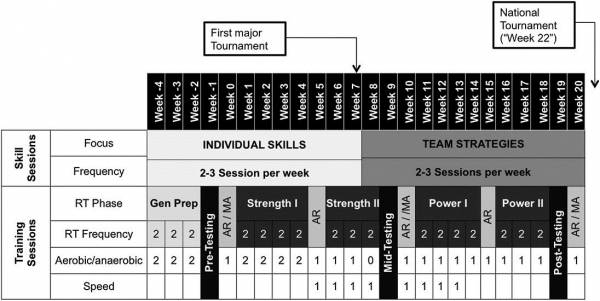A competitive season of a sport can be stressful and physically demanding on an athlete. While most spectators keep tabs on the win loss column, a recent study examined the performance changes that occurred in elite female softball players during 20 weeks of softball training (which included 14 weeks of resistance training). Researchers examined the changes in muscle architecture variables as well as performance variables such as speed, strength, and change of direction performance.
Ten female softball players participated in the study. The players were tested for maximal lower-body strength using their 3RM, and their 1RM was predicted from this using an existing equation. Also, peak force, peak velocity, and peak power were measured during loaded and unloaded jump squats. First base and second base sprint performance, change of direction on dominant and non-dominant sides, aerobic capacity, and muscle architecture characteristics of the vastus lateralis (thigh or quadriceps muscle) including muscle thickness, fascicle length, and pennation angle were also examined. These testing sessions occurred pre, mid and post training, for a total of 20 week before and during season training.1
The athletes continued with normal training as they would in a typical season, which involved conditioning and speed sessions as well as resistance training sessions, while also participating in normal skills training 2-3 times per week. A major tournament occurred during week 7, and the national tournament in which players peak for was in week 22.2

After analyzing the data, it was found that significant improvements in peak velocity and peak power happened at all jump squat loads (pre to mid-training testing, and pre to post-training testing). There were significant increases in absolute 1RM, relative 1RM, change of direction on non-dominant sides, and second base sprint. The strongest relationship found was the percentage change in vastus lateralis thickness and improvement of first base sprint performance. Other significant relationships were change in fascicle length and second base sprint performance, and percentage change in relative 1RM and change of direction on the dominant side.3
Summarizing the results, it was evident that elite softball players can experience gains in strength, power, and performance while participating in a resistance training program, even during their regular season. Additionally, changes that occur in performance are also associated with changes in muscle architecture. These physiological changes in female softball athletes had not previously been researched and recorded. According to researchers:
The periodized program, involving both a strength-power– and power-strength–emphasized mesocycle, used in this study demonstrates that RT [resistance training] has large benefits of not only maintaining but also improving strength and performance during preseason and in-season training. Therefore, the maintenance of a RT program throughout the in-season training should be considered by coaches and strength and conditioning specialist to be of high importance.4
As long as it is well organized and does not interfere with performance, resistance training can be a very beneficial tool for athletes, both in-season, as well as after season.
Photo courtesy of Shutterstock.






